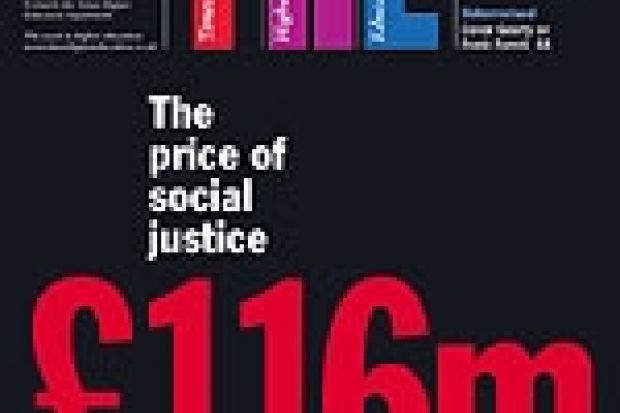When Malcolm McVicar ringfenced 70 per cent of the future income that the University of Central Lancashire would generate from top-up fees, he wanted to make a real difference to the lives of some of the country's poorest people.
McVicar's decision would mean that £7 out of every £10 the university earned through top-up fees would be ploughed straight back into providing bursaries for students who met the means-tested criteria, namely those from the poorest backgrounds.
As an institution with a proud record in providing higher education to people from what are euphemistically called "non-traditional" backgrounds - not so long ago they would have been called the working classes - it was entirely reasonable that McVicar, the vice-chancellor, made such generous provision.
What surprised him was the lack of take-up on the generous provision. Just over 40 per cent of the university's top-up income was actually disbursed to needy students.
"There is a real commitment to access here," says McVicar, "but don't forget this was the first time this has been done in the UK. Given that we had no experience to go on we were just being over-cautious.
"We did have problems with students not collecting their bursaries. They didn't apply for them. We did quite a lot of work to publicise this with students. We did what we could but we have given out more information earlier this year."
According to the Office for Fair Access figures, UCLan's 40 per cent is still enough to make it the highest placed university in a table of bursary spending as a proportion of top-up fee income. But its experience of over-estimation and/or lack of student take-up is repeated at universities across the country.
Overall, institutions estimated they would spend on average £115 million, or 25 per cent of their total additional fee income, on bursaries. In the end they spent £96 million or 21 per cent of their extra income. The majority of universities in the Offa survey (58 per cent) had spent less than 90 per cent of their predicted expenditure.
The Offa figures also show how much is spent on outreach work to attract students to university and again there was an overestimation. Institutions estimated that £25 million would be spent on additional outreach work, but just £20 million was allocated to this. The report said it had been difficult for institutions to make the early estimations about how much of their fee income they would have to spend on widening participation, both in terms of outreach work and student support.
Though University College London and Oxford fare well, newer universities dominate the top quarter of the table.
UCLan is closely followed by the University of Bedfordshire. And, out of the 20 institutions at the top of the table, 11 are post-92 universities, four are pre-92s and the remainder are specialist colleges and higher education institutions.
For McVicar the fact that newer universities are tending to invest a greater proportion of additional fee income in bursaries raises questions about efforts being made by different institutions to support poorer students.
"I think it's unfair," he says. "If most of your intake is working class you're going to give out more money. That needs to be (acknowledged) on a national level. These institutions are having a greater proportion of their money go on bursaries and it will affect tuition if you're not careful."
Bedfordshire also spent 40 per cent of additional fee income on financial support.
"We thought that our bursary offer to our students was virtually the most generous in the country," says vice-chancellor Les Ebdon. "We are a widening participation university. We're proud to be that. We carry more of the burden. We wish we were recognised for it." He said a national bursary system would help cover costs.
But Ebdon admitted Bedfordshire too had a problem with student take-up. He put this down to the profile of his university, which caters for a high proportion of students from poorer backgrounds.
"The middle class are better at claiming their benefits than anybody else," he says.
The Offa report acknowledges that it had been difficult for institutions to make the early estimations about spending on widening participation, both in terms of outreach work and student support.
Three new universities, Leeds Metropolitan, Greenwich and Middlesex, also appear near the bottom of the table though in two of the cases there are specific reasons for this.
Leeds Metropolitan spent only 1.3 per cent of its new income to provide bursaries. It predicted it would not have to use additional fee income for bursaries at all. This is because the university discounts all fees, charging students £2,000 instead of £3,000.
"Some people have referred to our reduced fees as a bursary for everyone. It is also worth remembering that bursary schemes can be costly to administer," a spokeswoman for Leeds Metropolitan says.
Greenwich predicted that it would spend 24.1 per cent of additional fee income on bursaries, but it spent just 6.6 per cent of its additional income on student aid, which, on the face of it, puts it among the lowest spending universities in the country. However, a spokesman said this was because it had charged tuition fees of just £2,500 in 2006-07.
"The data provided by Offa does not compare like with like," says the spokesman. "If we treated the fee reduction of £500 as a bursary, the percentage of additional fee income spent on helping disadvantaged students would be in the order of 35 per cent.
"Even without taking the reduced fees into consideration, the amount of bursaries and support funds available to our students stands at 24.1 per cent - our estimated bursary expenditure figure.
"The take-up in 2006-07 was 6.6 per cent and we are therefore taking additional steps to ensure that students access the discretionary funds available to them."
Middlesex gives no explanation for the low take-up of its bursaries, but issued a statement saying "the reason Middlesex is spending less than expected of increased fee income on bursaries is partly, we believe, because we overestimated the number of eligible students. All Middlesex students who applied for bursaries and met the criteria got them last year."
David Barrett, assistant director of Offa, says: "Any university which has a lower than full fee would argue that is just as valid in terms of financial support as charging a full fee then offering a bursary."
The Offa report claims that the main reason for the sector-wide underspend was an over-estimation of the number of students who would qualify for financial support. The Offa report shows that up to 12,000 students on full state support who were eligible for a bursary failed to claim one. That is a failure rate of up to 15 per cent, enough to raise serious questions over the effectiveness of widening participation programmes.
Concerns over effectiveness are compounded by the £1.7 billion spent by the Higher Education Funding Council for England since 2004 on widening participation including money for its AimHigher initiative.
While admirable in their intentions, initiatives like AimHigher have spanned a period in which the numbers of students from lower socio-economic backgrounds have dropped. Figures from the Universities and Colleges Admissions Service show that in 2005, before variable top-up fees were introduced, 89,050 Ucas applicants from lower socio-economic backgrounds applied and were accepted into university. This dropped by 1.24 per cent to 87,946 in 2007.
Some of the reason for the 12,000 who failed to receive a bursary is due to the system of means-testing. Local education authorities carry out means-testing for the Student Loans Company, which uses this information to calculate eligibility for state grant. Each student is asked to tick a box which allows the SLC to share the means-testing information with their university or college. This information is used by many institutions to award bursaries.
But, according to data provided by the SLC, many of the 12,000 students on full state support missed out because they failed to tick the box. A proportion of students are also thought to have missed out after ticking the box but failing to come forward for a bursary at university.
Offa has written to those institutions it feels were not sufficiently proactive in encouraging students to claim the financial help they deserve. The institutions are: Brunel University, Courtauld Institute of Art, the University of East London, Goldsmiths College, University of London, Leeds College of Music, London Metropolitan University, Middlesex University, the University of Northampton, Ravensbourne College of Design and Communication, Rose Bruford College, the Royal Agricultural College, the University of Salford, School of Pharmacy, Trinity & All Saints, and University College for the Creative Arts
Barrett believes that the tick-box system, effectively requiring students to opt in to information-sharing between the SLC and their university, appears to be at the root of the problem.
"A proportion of students may have misunderstood the form or misunderstood the importance of ticking that box in order to access institutional support," he says. "That may be because they're unaware of the extent of support available, or maybe because they're worried about data-sharing. Universities have tried to make as clear as possible what bursaries are on offer and how to claim them, and during the year they have tried to raise awareness among students that they need to tick that box in order to access support."
Barrett says students were able to apply for aid retrospectively once they realised they were eligible, which was why bursary awareness campaigns were important.
But he adds: "What has surprised the sector - including the student unions - is the extent to which they aren't claiming the bursaries they're entitled to, despite these campaigns."
The Offa data highlight some interesting anomalies. The University of Wolverhampton, a sector-leading institution in widening participation, spent significantly less than it had predicted on support for its poorest students. It did not allocate any of this extra income to additional outreach work.
Caroline Gipps, the vice-chancellor, admitted the level of bursary uptake had been far lower than she had expected.
"The socio-economic profile of our UK entrants remains unchanged and we have an extended programme of outreach projects," she says. "The main reason for the shortfall is because a percentage of students have not agreed to share income data or have not provided this to the Student Loans Company."
Wes Streeting, vice-president for education at the National Union of Students, says that universities are guilty of a "shocking failure" to publicise their bursary schemes effectively.
"We expect institutions to begin urgent discussions with student unions about the design and promotion of their bursary packages, and to implement Offa's recommendation to retrospectively award bursaries to those students who were entitled to them," he says. "By working in partnership with these student unions and NUS, we hope to see substantial improvements from these institutions in the year ahead."
Streeting says the problems would not exist if a national bursary scheme were established. "It would reduce bureaucracy and ensure that financial support is based on what students need, not where they study. We believe the case becomes more compelling with each passing year and we will make that case forcefully when the 2009 review begins work."
Offa has commissioned a survey to ask students and their parents or guardians why they refused to share the financial information required and the results are due in the next few months. In addition, from 2008 students will have to opt out of sharing their information rather than opt in, which, it is hoped, will also help to resolve the problem.
David Willetts, the Shadow Universities Secretary, says that the 12,000 students who were eligible for bursaries but did not get them had been "defeated by the bureaucracy of means-testing".
"It may be there's an underlying issue here," he says, "that parents don't want that amount of information about their finances known; let's hope that it is something as minor as that."
Describing as "extraordinary" the variation between the proportions of additional fee income universities predicted they would spend on bursaries and their actual spending, Willetts says he hopes the gap between institutions will narrow as the system beds in.
He suggests that the fact that post-92 institutions typically spend more of their additional income on student aid than older universities adds weight to calls for the review of tuition fees to be brought forward.
"This suggests that new universities are bearing the heaviest burden from tuition fees and is the kind of issue that needs to be looked at as part of a whole review of how the fees regime is working," Willetts says.
"Instead of a quick and dirty review in a few months in 2009, we would much rather get on with it and use this kind of evidence for a thorough review of how the system is working."
While institutions such as the University of Wolverhampton over-estimated how much they would spend on bursaries, others spent more than predicted. For example, the University of East London spent almost three times the proportion of additional income on student bursaries than it predicted - 30 per cent compared with the 11.5 per cent forecast. The university was discussing the figures with Offa as Times Higher Education went to press.
The contrasting approaches of old and new institutions is evident where universities with different missions operate side by side.
The University of Cambridge, for example, spent 19.4 per cent of additional fee income on bursaries, less than the 26.5 per cent it predicted, while Anglia Ruskin University spent 29.5 per cent - more than treble the 7.8 per cent it forecast.
For some in the sector, the variance is indicative of new universities having to compete harder for students by investing more of their additional income in financial aid.
"Our initial Offa proposals were revised to provide greater encouragement to potential students," says a spokesman for Anglia Ruskin University.
"In the original scheme, full-time Hefce-funded undergraduate students on typical three-year degree programmes would have received no payment in year one, but would have received support in years two and three as a type of loyalty bonus.
"This pattern of disbursement was subsequently reviewed in order to provide incentives for entry as well as progression."
The University of Cambridge says it operates generous bursary schemes funded from sources other than additional fee income.
John Rallison, director of Cambridge's Isaac Newton Trust, says: "The university has advertised a guarantee of support to students who meet certain conditions and we will pay whatever it costs to meet that guarantee, wherever possible using contributions from alumni and others."
Cambridge recently raised the upper limit at which students from low-income homes would be entitled to a full bursary from £18,000 to £25,000.
The new limit will be in operation for the next academic year and will benefit up to a third of students, raising the university's spending on bursaries from £2.1 million this year to an estimated £3.2 million.
Pam Tatlow, chief executive of Million+, says that the Offa report is a "health warning" about the current system.
"There is no doubt that universities which have a first-class record in widening participation have done what they said and spent significant amounts of additional fee income on providing discretionary bursaries for full-time students and outreach work," she says.
"These universities have more students from lower-income families and this is an excellent performance which, ironically, has the potential to reduce the unit of student resource compared to other institutions."
But Tatlow adds: "The failure of students to claim bursaries confirms our own research that the higher education funding and student support system in the UK, and in particular in England, is enormously complex, not only for universities to administer but for full-time students themselves.
"It is also quite bizarre," she says, "that students from the same socio-economic background studying the same course receive different discretionary bursaries according to the university at which they study and what that university judges it can afford to pay.
"This is neither equitable nor fair and it is why a number of English HEIs have always advocated a national bursary scheme - a policy subsequently adopted in Wales."
The Russell Group says its members - the larger research-led universities - spend on average 22 per cent of their additional fee income. The group points out that its members cater for smaller proportions of eligible students so that, relatively speaking, these institutions were more generous than they might first appear. On average, students from the lowest-income backgrounds across the group received bursarial support of £1,680 - almost six times the minimum bursary required by Offa of £300.
"Offa data attest to the enormous efforts Russell Group universities have made to help less well-off students. In 2006-07 the group spent well over £20 million of additional fee income on support for low-income students - a greater share than the sector as a whole and nearly £500,000 more than the sector average per institution," says Wendy Piatt, director general of the Russell Group.
"In some institutions guaranteed support was as much as £4,000 for the first year of study. Guaranteed support is supplemented by a large number of schemes targeted at high-achieving students or more specific under-represented groups.
"There can be no room for complacency. By 2010-2011, the value of bursaries and scholarships offered by Russell Group universities in England will be an average of over £5 million per institution per year."
The 1994 Group, representing smaller research-led universities, says it is doing its part to support students from a lower socio-economic background.
"A significant proportion of 1994 Group members who have reported an underspend on scholarships and bursaries have commitments to reallocate the underspend on other widening participation activities," says a spokesman.
Steve Smith, chair of the group and vice-chancellor of Exeter University, says: "The reality of the situation is that our institutions have committed to invest £15.5 million in new student support and outreach in year one of the bursary system compared to a forecast of £16.5 million."
Smith added: "Where institutions have overspent or underspent, it is for good reasons that are understood and accepted by Offa. The number of eligible students across the sector who failed to receive bursaries can be attributed to the teething problems that Sir Martin identifies and the 1994 Group is fully committed to resolving these hopefully one-off difficulties."
Rick Trainor, principal of King's College London and president of Universities UK, describes the £96 million paid out in bursaries as "a cause for celebration".
"This will go up in the next two years as more students come under the new fee regime," he says.
"Offa's report shows that the sector as a whole was pretty close to the mark when estimating the likely take-up of bursaries.
"It was always going to be difficult to predict take-up, not least because institutions were drawing up their access agreements based on government student support thresholds before these were announced. Institutions simply didn't have the necessary data at the time about the number of students likely to be eligible."
Trainor says that institutions made "strenuous efforts" to get bursaries to all eligible students, but agreed that efforts had been hampered by students not giving the SLC consent to share data. "We're pleased the process has been much improved for 2007-08."
It is important to the Government that the poorest students receive bursaries. The main reason that access agreements are submitted to Offa in the first place is because the Government needed to buy off a threatened rebellion by Labour backbenchers against the 2004 Higher Education Act, which paved the way for top-up fees. Offa was set up as the fees watchdog, to ensure that universities seeking to charge top-up fees also offered reasonable bursaries to the poorest.
Bill Rammell, the Higher Education Minister, is pleased with what he describes as the "commitment of the entire sector" to providing student support. He points out that Offa has confirmed that all institutions met their commitments set out in their access agreements.
"Take-up has been high but we are not complacent about this, and we are continuing to encourage students to ensure that they receive all of the funding to which they are entitled," Rammell says.
"I am very pleased HEIs have been trying so hard to ensure that their students are receiving all of the financial support available. The Government remains fully committed to widening participation in higher education.
"I am proud to say that from 2008 more students than ever before (two thirds of eligible undergraduates) will be entitled to a non-repayable maintenance grant - this means 100,000 extra students a year will benefit from some level of grant support when they study.
"This is of course in addition to support available in the form of loans for tuition fees and living costs, and the bursaries that universities offer, meaning nobody should be put off considering higher education for financial reasons."
The problem for Rammell and his colleagues in Government is that the Offa report and the reaction it has generated from the higher education sector show some serious failings in the system.
Time will tell if these are teething problems. But the decline in the numbers of students since 2005, as evidenced by the Ucas figures, indicates perhaps that the problems may be more long term. This is despite significant investment in widening participation by Hefce over the period.
What unites this and the issues raised by this week's Offa report is that throwing money at a problem is only part of the answer. What really counts is how effective the investment is.
SIR MARTIN HARRIS: YEAR OF THE 'BLIP'
A fall in the number of students from poorer backgrounds since tuition fees were introduced is a "regrettable blip", the director of the Office for Fair Access has said.
According to figures published by the Universities and Colleges Admissions Service, the number of successful applications from students from lower socio-economic groups fell by 1.24 per cent between 2005 - before top-up fees were introduced - and 2007, from 89,050 to 87,946.
"Any reduction in the proportion of students from lower socio-economic groups is to be regretted," says Sir Martin Harris, Offa director, "but I think that the enhanced financial packages now in place should really ensure that no students are deterred on financial grounds.
"I believe there was a blip caused by student understanding of the financial arrangements when they were applying for 2006 entry.
"To put it in a broader context, of course financial support is a very important factor in determining whether a student from a less privileged background goes to university, but it depends just as much on encouragement from their families and schools.
"I personally don't believe relatively minor changes to the student support system are the crucial determinant in whether students from those social groups apply.
"The outreach activities universities engage in and (their) work with schools are likely to be decisive."
Huge sums of money are being invested in widening participation by the Government and universities and Sir Martin believes it is having the desired effect, even though he admits that it is impossible to quantify the benefit of that investment.
"We can never know the answer to that, but what I can say is that with Government support and university bursaries, those who said there would be a dramatic reduction in poorer students coming to university have been shown to be wrong. I think that's pretty objective."
He also says it is no surprise that new universities are typically spending a higher proportion of their additional fee income on student support.
"Yes it is factually correct that some universities devoted a higher proportion of their gross additional fee income to students because they have been particularly successful in recruiting students from those backgrounds that warranted support," Sir Martin says.
"If the (Higher Education Act 2004) had proposed taking all the fee income and divvying it up equally, it would never have got through.
"One of the consequences is that some universities gain significantly more net than others."
Pressed on whether new universities were paying the price for social justice, he said: "As was famously said in House of Cards: 'You might say that, I couldn't possibly comment.'"
A major failing identified by the Offa report was the 12,000 students who were eligible for bursaries of at least £300 each, but who failed to get them because they didn't tick a box on the local education authority form which would allow their financial details to be shared with their prospective university.
Those students who slipped through the net could still have been picked up further down the line, and Sir Martin said both the universities and students involved had obligations to fulfil.
"Clearly universities had an obligation to identify these students, and some clearly tried harder than others," Sir Martin says.
"Nonetheless, I do think that when a student is in the top 40 per cent of the ability range and knows from one cheque that they're entitled to another, they might conceivably go and get it."
In an attempt to prevent a repeat of the problem, Offa has written to universities judged not to have done enough to raise awareness about financial support available.
"We've said they may wish to review the steps they take to identify students who are entitled to bursaries, but I think we've done the main thing - the government lawyers have been persuaded to reverse the box-ticking," says Sir Martin.
"I wanted the box done away with altogether, but the government lawyers said we couldn't do that.
"I believe - although we won't know until next October - that that will automatically identify far more of these students."
Overall, Sir Martin says that the sector, which was operating "in the dark" when it devised schemes before the fees were introduced, "really didn't do badly".
"If there were any significant numbers of students who were entitled to money, asked for it and hadn't got it, we would have heard a great deal about it," he says.
OUTREACH SUMS VARY HUGELY
The sums of additional fee income spent on outreach work vary hugely, with some universities spending more than £1 million and others recorded as not spending a penny.
The two biggest spenders were the University of Newcastle, which spent £1,197,000, and the University of the West of England, which spent £1,160,000.
By contrast, eight institutions - including the University of Cambridge, Aston University and the University of Wolverhampton - spent no additional fee income on outreach work.
Across the sector, £20,674,000 of this money was spent on outreach work. This fell around £4.5 million short of the forecast expenditure of £25,093,000.
According to Offa, this shortfall could in some cases be attributed to institutions achieving their aims at a lower cost than they initially predicted.
Other explanations included delays in recruiting staff, difficulties in pinpointing expenditure from additional fee income and reductions in expenditure to reflect lower than expected income.
Commenting on discrepancies, David Barrett, assistant director of Offa, says it is difficult to draw conclusions.
"It was never an expectation from Offa that everyone needed to do outreach work, and probably more did so than we expected to."
The University of Cambridge, explaining its poor showing, says: "Cambridge is among a number of universities who do not hypothecate fee income to a particular purpose. We have, however, substantially increased the money available for access."
Newcastle, which spent more of the extra cash on outreach than any other, says: "The additional income provided by variable fees has given us an opportunity to extend our outreach activity beyond the local region."
Wendy Piatt, director general of the Russell Group, says the group's universities had increased funding for outreach work to £5 million since the introduction of fees.
But says Piatt: "Universities cannot make headway in raising the proportion of low-income students at university alone. It is vital that this problem is attacked by several different agencies."
Pam Tatlow, chief executive of Million+, says: "It is far from clear that the use of additional fee income will have made any great inroads into a more inclusive social profile across all institutions.
"This report confirms yet again that institutions which have a higher proportion of students attending on a full-time basis and a less inclusive student profile have a clear resource advantage."
Register to continue
Why register?
- Registration is free and only takes a moment
- Once registered, you can read 3 articles a month
- Sign up for our newsletter
Subscribe
Or subscribe for unlimited access to:
- Unlimited access to news, views, insights & reviews
- Digital editions
- Digital access to THE’s university and college rankings analysis
Already registered or a current subscriber? Login




